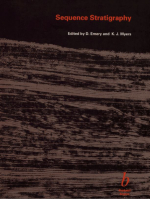Добрый день, Коллеги. Важное сообщение, просьба принять участие. Музей Ферсмана ищет помощь для реставрационных работ в помещении. Подробности по ссылке
Sequence stratigraphy / Секвенс-стратиграфия (стратиграфия непараллельно-слоистых образований прибрежноморских обстановок)
In 1989, the chief geologist of BP Exploration and his senior colleagues recognized the need to expand the company’s resource of sequence stratigraphers, and created the Stratigraphic Studies Group. This group initially included a few experts, but was composed chiefly of a mixture of willing geophysicists, sedimcntologists and bio-stratigraphers, who were to train as sequence stratigraphers, but more importantly, were to bring the expertise from their own disciplines to bear on sequence stratigraphy. This merging of geological disciplines with sequence stratigraphic principles first saw the light of day as BP’s ‘Introduction to Sequence Stratigraphy’ course. This course has been given internally since 1991, and has been presented in whole or in part to over a dozen national oil companies and at several international geological and geophysical conferences. The ‘Introduction to Sequence Stratigraphy’ course manuals formed the basis for this book, because, as we naively thought, it would not be too much trouble to recast the manuals in the form of a textbook, which could form the basis of university and professional courses. Inevitably, it was more difficult than we had imagined. Sequence stratigraphy is a rapidly evolving subject, new terminology was being added as we wrote, and the jargon we sought to demystify continues to grow. This book must thus be seen as a sequence stratigraphic synthesis for the mid-1990s, and not the final word on the subject. It is above all a practical guide and contains tools and techniques that the authors have found useful in their daily work.
We have arranged the book to cover four main themes; a brief history of sequence stratigraphy, concepts and principles, sequence stratigraphic tools and finally the application of sequence stratigraphy to different depositional systems. For the last theme, we have tried to emphasize the importance of seeing sequence stratigraphy in its sedimen-tological context, and it is recommended that the reader should have some familiarity with scdimentological processes before tackling the last five chapters. Otherwise,
the book covers all the basics of sequence stratigraphy, and is intended to be a broad text suitable for undergraduate geologists of all years, MSc and PhD sedimcntologists and stratigraphers, and for oil company geoscientists who wish to broaden their knowledge of the stratigraphic methods available for solving problems with which they are routinely faced. We hope you find it interesting and useful. <...>




